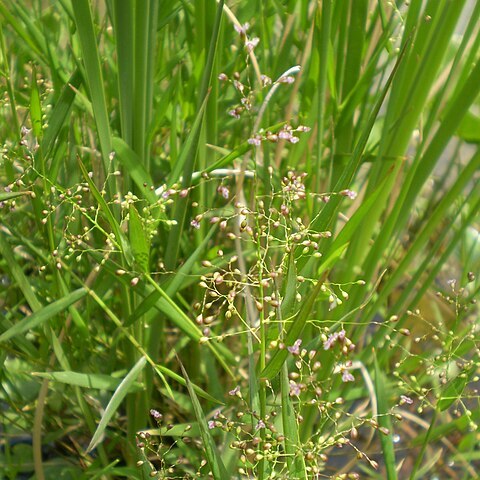Annual or perennial. Culms erect or decumbent or creeping, many-noded. Leaf blades narrowly lanceolate to ovate, margin frequently white and thickened; ligule a line of stiff hairs. Inflorescence an open or contracted panicle, branches and pedicels sometimes spotted with yellow glandular patches. Spikelets with 2 florets, florets both bisexual or lower floret bisexual or male and upper floret male or female, separated by a short internode or contiguous, disarticulating below each floret; glumes falling soon after florets, subequal, 3/4 to as long as spikelet, 5–9-veined; lower lemma variable, resembling the upper or of different size and texture; upper lemma orbicular to broadly elliptic, papery to leathery, glabrous or pubescent with short curved hairs, 5–7-veined, obtuse. Stamens 3. Caryopsis ellipsoid or subglobose.
Animals or perennials, often aquatic; culms commonly ascending from a prostrate base. Leaf-blades linear to lanceolate or ovate. Inflorescence an open or contracted panicle. Spikelets 2-flowered, with the florets similar or dissimilar, the lower ♂ or hermaphrodite, the upper ♀ or hermaphrodite; rhachilla disarticulating below each floret; glumes falling soon after the florets, subequal, two-thirds to as long as the spikelet, membranous; lemmas elliptic-oblong to orbicular, obscurely 5–7-nerved, obtuse, the lower similar to the upper or larger and thinner, the upper chartaceous to thinly coriaceous; stamens 3. Caryopsis ellipsoid to suborbicular, dorsally flattened on one side.
Spikelets subglobose with two well-developed florets, the lower perfect or staminate, indurate and similar to the upper, or herbaceous and similar to the glumes, the rachilla segment between the florets evident; glumes equal, similar, shorter than the spikelet, exposing the florets; fruit plano-convex, indurate, the narrow margins of the lemma inrolled.
Florets similar or dissimilar, separated by an abbreviated internode, the lower sometimes male.
Glumes subequal, 3/4 to as long as spikelet, 5–9-nerved.
Superior lemma crisply chartaceous to crustaceous.
Inferior lemma membranous to coriaceous.
Inflorescence a panicle.

